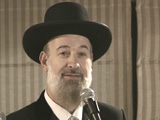- Sections
- Peninei Halakha
- Shabbat and Holidays
- Peninei Halkha - Hanukkah
The Talmud describes the story of Ĥanuka, which occurred during the Second Temple era, in a brief passage:
When the Greeks entered the Temple, they defiled all the oils therein. When the Hasmoneans prevailed and defeated them, they searched and found only one cruse of oil that was marked with the seal of the High Priest, but which contained sufficient for one day’s lighting only; yet a miracle was performed there and they lit [the Menora] for eight days with this [oil]. Another year these [days] were designated a holiday with [the recitation of] Hallel and thanksgiving. (Shabbat 21b)
It is likewise forbidden to fast or deliver eulogies on these days (Megilat Ta’anit 9:2).
The Sages established many holidays during the Second Temple era, to thank God and rejoice over the salvations He performed for Israel. These holidays are all mentioned in Megilat Ta’anit. Many of these holidays commemorate the victories of the Hasmoneans: 13 Adar was "Nicanor Day," when the Hasmoneans defeated a large Greek army and killed their commander, Nicanor; 14 Sivan was the day they conquered Caesarea; 22 Elul, when the Hasmoneans killed the apostates who refused to repent; 23 Marĥeshvan, when the Hasmoneans destroyed the brothel that the Greeks had built near the Holy Temple; and 25 Marĥeshvan, when they conquered Samaria and began settling it.1
However, after the destruction of the Second Temple, the Sages abolished Megilat Ta’anit (sa 573:1) because all of the wonderful things that happened on those days were no longer relevant and thus no longer constituted a reason to rejoice. One may even fast and deliver eulogies on these days. Only Ĥanuka remains of all those day, as the Sages explain, because of the unique miracle of the oil that it commemorates and the mitzva of lighting Ĥanuka candles that the Sages enacted to publicize the miracle. And since we already observe the mitzva of lighting the Ĥanuka candles, we also preserve the other aspects of the holiday: we thank God by inserting Al Ha-nisim into our prayers; we praise God for saving His people by reciting Hallel; and we refrain from fasting and eulogizing throughout the holiday (see rh 18b; Rashi and Ritva ad loc.).
In order to understand better the significance of Ĥanuka and the miracle of the oil – the only remnants of all the holidays that existed during the Second Temple era – we must elaborate a bit on the events of those days and their meaning.

4. Mishlo’ach Manot
Chapter 16: The Mitzvot of Joy and Kindness
Rabbi Eliezer Melamed | Tevet 5 5782

16. Costumes and the Prohibition of Lo Yilbash
Chapter 16: The Mitzvot of Joy and Kindness
Rabbi Eliezer Melamed | Tevet 10 5782

Chapter 6 – Yom Kippur
Rabbi Eliezer Melamed | 4 Tishrei 5784

14. Hotels
Chapter 13: When and Where to Light Hanuka Candles
Rabbi Eliezer Melamed | Kislev 12 5782

(For me, Closeness to Hashem is Good” (Tehillim 73:28
Rabbi Yossef Carmel | Tishrei 4 5777

Yonah ben Amitai
Rabbi Shaul Yisraeli zt"l | 5774

In Search of the True Nesher
Rabbi Yirmiyohu Kaganoff | 5770

Hamapil for Those Who Take a Long Time to Fall Asleep
Rabbi Daniel Mann | Shvat 5773

The Yom HaZIKARON SIREN- EVERY ARROW NEEDS A HEAD!
Rabbi Ari Shvat | Iyar 5785

Tolerance but Not at All Costs
Ayn Aya Shabbat v, 73
Rabbi Ari Shvat | Iyar 5785

Daf Yomi Makkot Daf 24
R' Eli Stefansky | 4 Iyar 5785







